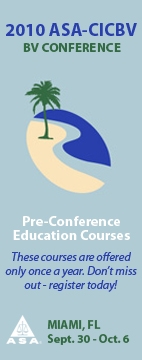Working with divorce lawyers - don’t let them take over your testimony
William Morrison (Morrison and Company) led a great session with Hon. Thomas Zampino (New Jersey Superior Court) and Mark Sobel (Greenbaum Rowe Smith & Davis) on the rules of evidence at the BVR/Morningstar 3rd Annual Summit on Business Valuation in Divorce on Monday in Chicago.
The panel agreed that, ironically, many divorce lawyers don’t have a lot of “actual, on their feet, trial experience” because most divorces don’t go to court. So, Sobel pointed out that “they might not be facile” when working with appraisers. A most common new litigator mistake is to take over an expert’s testimony. ”The judge wants to hear from the expert, not the lawyer,” he says.
Sobel trains other lawyers to attack appraisal reports in four areas fraught with assumptions:
- normalization adjustments to the income statements
- projected growth rates
- specific-company risk, and
- reasonable compensation, if any
“Each of these aspects have multiple subjective elements, so any lawyer will want to look at them, and any expert must prepare to be cross-examined on them.” Sobel cites a case where an expert argued for a 19.5% annual growth rate going forward–it was easy for this experienced trial lawyer to tear that number apart until the judge stopped him, but by then the damage to the expert was done. How do you deal with this as an expert? ”Admit there’s a subjective element. But, also point out that your subjectivity is tempered by your experience, your studies, the information you collected, all the work in put in, etc. So, it’s subjective, but it’s not a guess.” In cross-examination, Sobel feels this answer is the surest way to shut down the opposing counsel.
Another expert witness pointer: Expect judges (and lawyers) to talk to their peers who’ve worked with you before
“It may come as a shock but judges talk to one another,” Judge Zampino told attendees at the BVR/Morningstar3rd Annual Summit. So, if you testify that you’ve appeared in other courts, “I’ll call the other judges to find out what you’ve done there,” he confirms. This means that judges are more likely to know when you’re changing your standards of practice. One example: an expert in New Jersey who would tax-affect or not tax-affect, depending on which spouse he was representing in divorce cases. ”We keep files on all the leading valuation experts,” said attorney Sobel. “We have your past reports, what you’ve written, and other materials. Both the lawyers and the judges know if you’re subjectively changing your standards.”
A thorough report “changes the nature of the debate
in court”
Should you prepare a full valuation report for a divorce case that’s likely to settle? Sobel argues that you should. This conflicts to some degree with the idea that the more information you present, the more openings you offer for opposing counsel. But, Mark believes that a comprehensive report sends important subliminal messages. ”It says that you’ve done you’re work, and if settlement isn’t achieved, you’re ready to go to trial. That changes the nature of the settlement discussions.”
“As an appraiser, you can help the lawyers by explaining how much work goes into a valuation report,” Mark argues. ”You can put 50 hours into a one page normalization adjustment analysis.” So, Mark also feels longer reports help with settlement simply because he can argue that “30 days is not enough to examine an opposing report.” The judge will then face the choice of more time and cost, or looking for ways to settle differences early.
FASB’s tentative decision will require all investment property be reported at FV
At its August 31 2010 board meeting, FASB announced its tentative decision to issue a proposed Accounting Standard Update that would require investment property be carried at fair value, as defined in IAS 40. We called Al King (Marshall & Stevens) for his comments:
It looks like we will be able to kiss goodbye to the ‘convergence’ of GAAP with IFRS. FASB recently announced its proposals for the determination of the Fair Value (“FV”) of Investment Property and they differ markedly from existing IFRS rules. Both IFRS and GAAP define Investment Property as Real Estate that is owned passively to obtain a financial return, and is not used in a business for office space, storage or production.
IFRS first took the initiative on Investment Property several years ago, and provided an option to owners to report such assets at either historical cost or current Fair Value. The option, of course, once chosen, must be continued. You could not re-value a hotel, for example, (as long as you did not run it) when values were up and then switch back to historical cost if values went south. The initial choice was yours.
FASB recently added investment property to its agenda, with the initial idea of developing new accounting that would be the same as that in effect in IFRS. Under the current FASB proposal, however, all investment property would have to be reported at FV, with no option. In short, FV will be mandatory.
IFRS says that if it is impractical to develop FV then it can continue to be reported at historical cost. FASB says no exception for practicability would be permitted under GAAP. Under IFRS an owner of property who plans to develop it has to transfer such property to inventory but FASB says one would have to continue to use FV.
It appears as though FASB is dead set against giving companies any choices; one size has to fit all. So even though we will not be converging with IFRS, U.S. companies will now have to start determining the Fair Value of all Investment Property.
King believes the decision will result in significantly more work for valuation consultants who actively perform investment real estate valuations.
Look for an article in a future issue of BVUpdate by King on the longer-run implications for this mandatory use of Fair Value in U. S. financial reports. “For the first time, once adopted, FV will have to be used for hard assets, other than financial assets such as derivatives and financial instruments. The implications are far-reaching,” says King.
Is a private company always less marketable than a public company?
“We tend to think so,” argues Jay Fishman (Financial Research Associates), also speaking at the BVR Divorce Summit on Monday. But, if fact, “no one ever calls their broker and says ‘I want to sell 100% of Ford’.” Selling large blocks of public shares, as Ashok Abbot (Business Valuation LLC) has shown, has many discounts built in–and is subject to oversight from PCAOB, FASB, and other regulators.
Compare this to a private company where today’s lunch “may have included a quorum of the Board.” Fishman’s point: no matter what Thornhill says about discounts, not all private companies are harder to sell than public companies. Appraisers need to justify the circumstances that determine relative marketability challenges to determine any discount.
Professor Damodaran invites BVWire readers to class
Aswath Damodaran, Professor of Finance at the Stern School of Business at NYU started teaching another year of corporate finance and valuation. And, according to a recent post on his blog Musings on Markets he is “just as excited as I was the day that I taught my first class” in 1986.
Quoting Damodaran, here are two of several reasons he doesn’t mind “teaching the same class over and over:”
The issues that we face in valuation change constantly. When I first started teaching the class, the big issue was recapitalization, as many large US companies were shifting to using more debt in their capital structure. In the 1990s, interest shifted to valuing technology companies, in general, and young technology companies, in particular. The last decade saw the rise of emerging market companies in the first part and the banking crisis, towards the end.
First principles endure: While the issues and challenges that we face in valuation change constantly, I have adhered to the same first principles over time. In fact, it is these first principles of valuation that I return to, at times of uncertainty and crisis, to look for answers. I truly believe that if you "get" these first principles, you are capable of answering any question in valuation, and I view that as one of the primary objectives for this class.
If you find yourself wishing you could attend his class, now’s your chance. The popular professor invites us to “join in and follow the class”–virtually. The lectures, which can be downloaded, will be webcast a few hours after the class. He is also making his lecture notes and emails available. You can even take the quizzes and exams, which you’ll have to grade yourself with the help of his grading template online. To find out more click here.
Trivia question: has the Supreme Court ever considered the issue of celebrity value?
Mark Roesler, Esq. (CMG Worldwide) told the audience Monday at the BVR Divorce Summit the first case that allowed for individuals to maintain their “right of publicity” was the “Human Cannonball” Zacchini case (Zacchini v. Scripps-Howard Broadcasting Co. 1977). This involved a newsreel shot of a man who, while performing at the Geauga County Fair in Burton OH, shot himself out of a cannon; he claimed that the news coverage diminished his ability to capitalize on his skills. After the Supreme Court decision, state courts started to follow along, first in Virginia, and most comprehensively in states like Indiana and Tennessee–and now California. The California law is the most litigated, and it extends protection for 70 years. The law has been amended many times since the first efforts in ‘70’s.
Roesler, arguably the leading expert on rights of publicity in the country, mentions that a recent update is the Comedy III case (Comedy III Productions v. Saderup)–this is a good indicator of the “sufficiently transformative test.” The court felt that the IP rights of the original artists (in this case the Three Stooges) outweighed the artistic rights to reproduce the image. In this case, in balance, the court felt the transformation in the reproduction was not sufficient.
Another interesting case is Edgar and Johnny Winter (Edgar Winter et al. v. DC Comics et al.), says Roesler. The courts ruled there that the transformation to comic books was sufficiently transformative to protect the First Amendment rights of the comic book artists.
Working on an A/E valuation? Don’t miss Rusk and O’Brien
On September 23, BVR’s Industry Spotlight Series continues with “Valuing Architecture & Engineering Firms”, Ian Rusk and Michael O’Brien (both ASAs with Rusk O'Brien Gido+ Partners, LLC) will lead a 100-minute webinar on the challenges and opportunities in valuing architecture, engineering and landscape architecture firms. Two CPE credits are available. Click here to register.
What do Hon. David Laro, Mel Abraham, John Porter, and Jim Hitchner have in common?
They are co-hosting the Advanced Summit on Business Valuation: Resolving Tax & Legal Issues, in conjunction with the Georgetown School of Law, on November 10. At this one-day conference, attendees will hear from the top minds in business valuation, taxation, and litigation address the intersection of their respective fields. Presentations feature panel discussions with three U.S. Tax Court judges, and three representatives of the Internal Revenue Service, respectively. This advanced Summit is the day after the AICPA’s National BV Conference ends—to make it easy to attend. To find out more or to register, click here.
BizMiner adds new items to its Industry Financial series
BizMiner recently finalized the mid-term expansion of its Industry Financial series. All reports in the series now have two additional line items to clarify Fixed Assets in the balance sheet. Net Fixed Assets is now broken out into: Gross Fixed Assets, (less) Accumulated Depreciation and Net Fixed Assets. The new items appear directly in the data tables in HTML and PDF formats. In the CSV file, Net Fixed Assets is asterisked in the table and the detail presented at the end of the report. This was done to avoid complications and re-work for customers who have set up imports of the Industry Financial data into their own tools.
BizMiner covers 16,000 lines of business in 300 U.S. markets. No other source reports at this level of detail. Learn more about these financial reports and view samples here.
BV profession headed towards more specialization?
Rick Warner, ASA, AVA and editor of the BV-ELetter recently wrote that “fair value for financial reporting continues to develop its own accepted tools, techniques, and best practices perhaps leading someday to an additional accreditation noting a degree of competence within that area.” As a result, Warner believes that the BV profession is headed toward more specialization.” What do you think? Send comments to editor@bvwire.com.
BVR congratulates Sean Saari of Skoda Minotti
Sean Saari, CPA/ABV, CVA, MBA recently received the 2010 Jeffrey R. Salins Report Writing Award from the National Association of Certified Valuation Analysts (NACVA). The award, given each year to one of NACVA’s 7,500 members, acknowledges superior work in preparing a business valuation report.
GF Data reports many indices of a recovery in the
M&A market
Recent data from GF Data Resources reveals “increased deal volume, resurgent valuations and looser credit, particularly on larger middle-market transactions. In the 2Q10 there were 146 active private equity contributors reporting 26 completed transactions. “Our data continues to support the general impression that the premium for quality has never been greater,” the report states. GF Data Resources provides data on private equity-sponsored M&A transactions with enterprise values of $10 to 250 million. For more information email info@gfdataresources.com.
Wisconsin court announces new standard on goodwill value
The current majority rule among U.S. jurisdictions holds that the corporate component of the goodwill value of a private professional practice is a divisible marital asset, but the professional component is not. Wisconsin was among the majority until McReath v. McReath, WL 2943198 (Wis. App.)(July 29, 2010), which may have just revised the rule: All salable goodwill is a marital asset and subject to division, whether it is corporate or professional.
But wait a minute: Isn’t the majority rule based on the assumption that professional goodwill is never divisible, because it’s not salable? That’s what the husband in McReath tried to argue, but even he admitted that when he bought his practice from another dentist, the “lion’s share” of the purchase price—as much as 95%—was for professional goodwill, as evidenced by a non-compete. Similarly, if the husband were to sell his practice now, both parties (and their experts) agreed that a non-compete would effectively transfer a substantial portion of the husband’s professional goodwill to a prospective buyer under the fair market value standard.
Accordingly, “there is no serious dispute that a significant, but unspecified, portion of [the $1 million practice value] is attributable to salable professional goodwill,” the court held. Even so, the husband claimed that allocating salable profession goodwill value to the wife coupled with an award of maintenance (based on practice earnings) constituted an unfair double dip. The court saw a problem only if the husband continued to practice. What if he retired or even died after divorce? A rule precluding consideration of salable goodwill would cause the wife to lose her “full” share of the firm’s value—and then lose maintenance, too.
New opportunity for divorce experts? Interestingly, the court proposed an alternative: a trial court could include all salable goodwill in the practice division and then adjust maintenance to avoid a double-counting problem. But in this case neither party had presented expert testimony to explain how to offset business value against the maintenance, and so the court held that all salable goodwill in a private practice is marital property, and any non-salable goodwill, attributable purely to the professional, is not.
The complete digest of McCreath will appear in the next (Oct. 2010) Business Valuation Update™. We’ve also updated one of our most popular downloads, Goodwill Hunting in Divorce, to reflect the new ruling: get your copy here.
Free downloads continue to be popular with BVWire Readers
BVR provides over 90 free articles, papers and standards written by top experts in the field of business valuation.
The top ten downloads last month were:
- FORM PREM14A EF Johnson Technologies, Inc. – EFJI
- Historic Trends in Private Company Valuation Multiples
- The Top 5 Free Sources of Automobile Dealership Industry Information
- Reasonable Compensation Data Sources
- Control Premiums: Application & Analysis Special Report Excerpt
- How to Use Transactional Databases for M&A, 2010 Update
- How Much is Your Business Worth - According to Inc. and BVR
- Case Digests: Supreme Court Decisions in Daubert and Kumho Tire
- Personal Goodwill: A Survey of Definitions
- Reasonable Compensation: Can Your Opinion Survive this 12-point Checklist?
To ensure this email is delivered to your inbox,
please add editor@bvwire.com to your e-mail address book.
We respect your online time and privacy and pledge not to abuse this medium. To unsubscribe to BVWire™ reply to this e-mail with 'REMOVE BVWire' in the subject line or click here. This email was sent to %%emailaddress%%
Copyright © 2010 by Business Valuation Resources, LLC
BVWire™ (ISSN 1933-9364) is published weekly by
Business Valuation Resources, LLC
Editorial Staff | Advertise in the BVWire | Copyright Notice |





